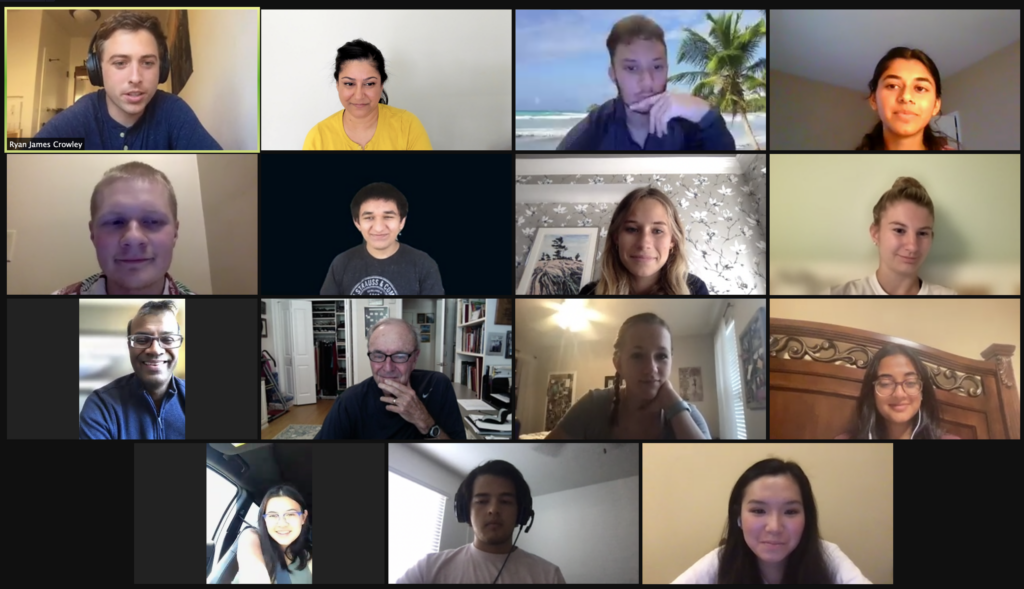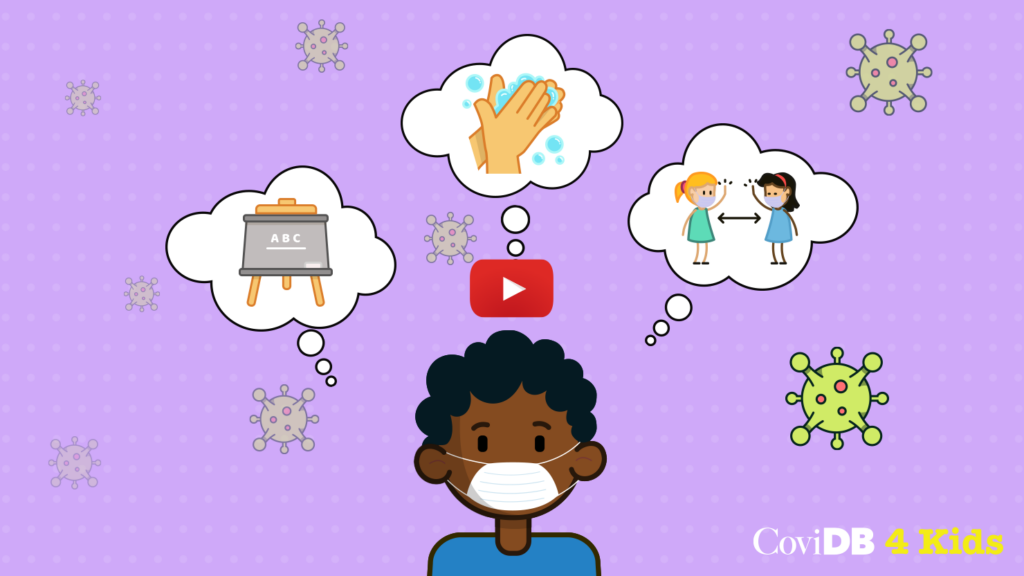Published: 03/22/2024
Student-powered initiative to provide trustworthy health information during COVID-19 has lasting impact
By Jamie Hansen, Global Health Communications Manager

Ryan Crowley ‘21 was a junior studying biomedical computation and excited about a career in healthcare when the COVID-19 pandemic struck in early 2020. As he watched the world shut down and medical providers spring into action, he wanted to contribute – but wasn’t sure how.
“For a lot of us who were interested in pursuing careers in healthcare, we felt helpless seeing all the work that frontline workers were doing and knowing that we didn’t yet have the training to be able to do that,” he recalled.
At the time, he was working as a fellow for TeachAids, an award-winning nonprofit that supports health education initiatives in 82 countries worldwide, led by Global Health Faculty Fellow Piya Sorcar, PhD. TeachAids has long involved students in its efforts, and not long after the pandemic arrived, a group of these students began developing a crowdsourced education and news platform. They sought to provide timely, expert-curated resources to mitigate the chaotic flow of unreliable information during the early days of the pandemic. Crowley jumped at the chance to be involved.
“This felt like something tangible I could do, and it brought some sort of meaning to the situation,” he recalled. Crowley coordinated a team of volunteers as they vetted information and developed the website.
This felt like something tangible I could do, and it brought some sort of meaning to the situation.
Ryan Crowley ’21
In all, more than 200 student volunteers, interns, and fellows contributed to the effort, joined and supported by more than a dozen faculty mentors from Stanford and others from leading universities across the US. With help from volunteer experts from Bay Area tech giants they built CoviDB.org, (the DB standing for database). CoviDB is a free, robust web resource providing trustworthy news and information about COVID-19 that eventually reached people in 140 countries around the world. It was the beginning of a multifaceted initiative to provide timely and trustworthy resources to communities that needed it. Over time, the team also launched an expert speaker series, teacher’s guides for K-12 schools, and a companion website designed for children.
Students involved in the project said the experience empowered them during a dark time and positively shaped their outlook on their role as agents of change.
The need for real-time, trustworthy information
By the time the WHO declared a global pandemic in March 2020, misinformation was already rampant. Sepehr Asgari (‘24), a Stanford sophomore at the time, remembers how hard it was to distinguish legitimate information, even with all the resources Stanford offered.
“At the time there was so much content coming out and yet little scientific evidence to contextualize the findings,” he recalled. He was an intern with TeachAids, working on a project about concussions. He quickly shifted his focus to the CoviDB project.
“CoviDB was so timely and a great utilization of what Stanford had to offer,” Asgari said.
“Ideas came from everybody.”
For those involved, CoviDB’s success lay in its democratic, community-powered nature.
Anyone who wanted to contribute was welcome, from high school students, to medical trainees, to senior faculty. Many students got involved because they’d taken a global health course with Sorcar at Stanford or were already volunteering with TeachAids.
Everyone did what they could on their own time, based on the information needs they identified. Then, the group came together once a week to discuss their findings and decide the best new additions to the site.
Ideas came from everybody, were listened to by everybody, and executed on by everybody.
Nate Braun, ’21
“Ideas came from everybody, were listened to by everybody, and executed on by everybody,” remembers Nate Braun, ‘21, who was a Stanford sophomore when the pandemic began.
Leila Orszag ‘22, a Stanford student at the time who got involved with TeachAids after taking a global health course with Sorcar, remembered the group discussing the most pressing information needs as the pandemic evolved. She appreciated that students were empowered to pursue whatever topic most interested them.
“You could choose your own interests because there were so many needs,” she said. “Since everyone had different interests, we ended up offering good information in lots of different areas.”
Students gathered stories and then vetted them with faculty mentors such as Stanford Global Health Faculty Fellows Anurag Mairal, PhD and Darvin Scott Smith, MD. Mentors provided feedback on which sources were most reputable, which were problematic, and how to identify other reputable sites. Students learned from this and incorporated their feedback into future searches. It was an incredible learning experience, Orszag said.
Since everyone had different interests, we ended up offering good information in lots of different areas.
Leila Orszag ’22
“It was great for us as high schoolers and college students to learn about the specifics of identifying reliable resources, and how to deal with information and scientific knowledge that was changing so rapidly,” she said.
Effort evolves with the pandemic

As the pandemic evolved, so did CoviDB, offering information on masks, social distancing, event guidelines, vaccines, and more.
After Braun identified a need to provide engaging and trustworthy information for children, a subset of the volunteers, including Braun and Crowley, threw themselves into developing a separate website to fill this need — CoviDB for Kids.
Realizing that many people best engage with information when it is heard, rather than read, TeachAids launched a speaker series that featured experts addressing many of the most pressing questions about COVID-19. They also intentionally addressed misinformation and common misperceptions in these videos. They then partnered with the Stanford Program on International and Cross-Cultural Education (SPICE) to develop teacher’s guides to accompany the video series. SPICE shared the series and guides with their partners across 30 countries and 10,000 schools across the US.
Over time, as the volume of information grew, the team realized they needed to find ways to automate the vetting process. Students with computer science expertise joined and developed a system that could automatically pull in relevant articles from vetted websites, such as universities, large nonprofits, and select news organizations. CoviDB runs on this automated platform today, continuing to provide timely resources from trustworthy sources.
Global impact

As the initiative evolved, the team wanted to ensure their efforts were helping people not just in the US, but around the world. Sorcar recalled the painful realization that vaccines were saving lives in some parts of the world while they remained completely inaccessible to others.
“It was immensely unsettling to witness how COVID further widened the gaps and disparities between populations,” she said. When friends and colleagues from India reached out for information about keeping safe until large-scale access to vaccines arrived, the TeachAids team began developing customized content to help fill these information gaps.
For instance, they developed a special episode in their video series, “Covid Tips for Everyday Situations in India” featuring beloved Indian actress, Amala Akkineni, and Global Health Faculty Fellow S.V. Mahadevan, MD.
Global health experts helped vet these international resources, including CIGH Director Michele Barry, MD, and David Katzenstein, MD, Professor Emeritus of Infectious Diseases at Stanford University and TeachAids Advisor.
“COVID-19 has presented a truly global problem that’s changing the lives of people across social and political demographics,” said Katzenstein at the time. “What CoviDB.org provides is an essential tool for making high-quality information available to everyone. Education is the best tool we have to keep our planet safe.”
Katzenstein, who was in Zimbabwe during the pandemic, died of COVID in early 2021. TeachAids dedicated CoviDB for Kids to his memory.
A lasting legacy
Crowley, now in medical school in New York described his part in this collaborative, solutions-oriented process as a “bit of joy in the abyss.” The effort also underscored for him the vast, systemic inequities in health and medicine. Seeing this deepened his desire to continue investigating how technology can be used to address these disparities.
Other students carry similar lessons from their time working on CoviDB. Braun, who is now working on a US Senate campaign in Ohio, recalls being trusted and supported to help develop CoviDB for Kids. It underscored a key theme Sorcar imparts in the classes she teaches, he said: “Every individual is capable of making a positive impact in the world.”
Orszag, who is now applying for medical school, said the experience increased her interest in public health as an important aspect of medicine. After working alongside TeachAids mentors with dual degrees in medicine and public health, she’s considering a similar path.
Asgari, now a senior, has continued working with TeachAids and is leading a research project investigating the impact of state laws requiring coaches’ education on the reporting of injuries. He said CoviDB shaped his sense of what is possible in global health.
When you have a mission that people buy into, it’s really easy to get them to help
Sepehr Asgari ’24
“It seemed daunting to gather such a large group of volunteers and big shots in their fields to contribute to solving a really hard problem,” he said. “But when you have a mission that people buy into, it’s really easy to get them to help. It’s given me confidence that it’s possible to do something like that in the future, and that I shouldn’t be afraid to ask for help.”